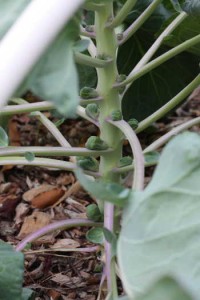Never cared much for brussels sprouts as a kid, which puts me in good company with most kids in the US, probably in the world. As an adult, however, I have embraced them as a nutritious delicacy.
Amanda and I planted brussels sprouts seeds in our feeble attempt at a fall garden last year, but they never germinated. Probably because their heart wasn’t in it, knowing as they did that if they dared show their tender green shoots the deer would quickly dispatch them.
This year, safe behind a seven foot deer fence, the Farmer-in-Chief planted brussels sprouts plants, not seeds, with delectable anticipation. Will we have brussels sprouts this year? Dare we hope?
We transplanted them on September 6, so they’ve been in the ground for 78 days, and they’re looking beautiful! Within two weeks of planting, we had the brussels sprouts (and most of the fall veg) protected under a row cover of Agribon AG-15 insect barrier. We pulled the row cover on November 14.
We think the insect barrier protection made a crucial difference in the development of the tender fall veg. They are now robust and verdant, and the bugs are less of a problem because of the cooler temperatures.
I am expecting our brussels sprouts to be tasty and will be shocked if they’re not. What I was not expecting was just how fun it is to watch them grow. When we have bought brussels sprouts at the market, they’re usually already separated from the stalk, so we just see a carton of the round little sprouts. Even when we’ve seen them on the stalk at a farmer’s market, the leaves are usually already gone, just leaving a bunch of sprouts on a stalk.
 Now I know what we’ve been missing. The tender sprouts form in the crotch formed between the main stalk and a leaf stalk. At first, we thought they were buds forming for new suckers, but we kept watching them round out and plump up, and eventually realized these were the sprouts!
Now I know what we’ve been missing. The tender sprouts form in the crotch formed between the main stalk and a leaf stalk. At first, we thought they were buds forming for new suckers, but we kept watching them round out and plump up, and eventually realized these were the sprouts!
Brussels sprouts are members of the brassica family, along with broccoli, cabbage, and collards. Each sprout in fact resembles a tiny head of cabbage. Wikipedia says they were probably grown in ancient Rome but that the variety we call brussels sprouts emerged in the 13th century in what is now Belgium.
If what we read is correct, our sprouts will mature from the bottom of the plant to the top, beginning a week or so after Thanksgiving (that is, 90 days after planting), and they will continue to mature until well into January. Because we are small-scale, we have the luxury of harvesting by hand, so we will pick just a few of the most mature sprouts every other day or so, being careful not to let them turn yellow.
We will also be careful not to overcook them, which releases the sulfurous taste every kid can remember. As much as we love the sun oven, we’ll need to be careful in using it to cook brussels sprouts, because it’s easy to overcook veg using the sun. We’re partial to the taste of brussels sprouts with no seasoning, but if that’s not your cup of tea, you can bathe them in a little olive oil and garlic powder to perk up the taste. Just don’t overcook them!
The video runs less than a minute.